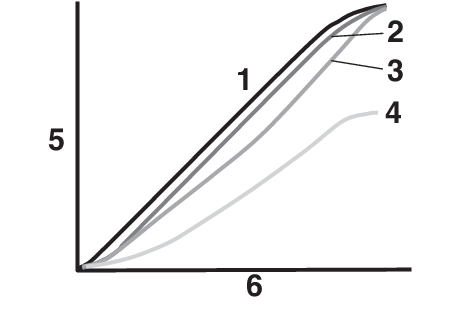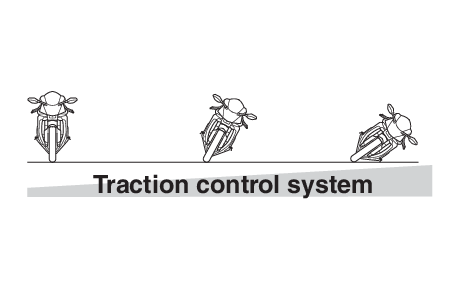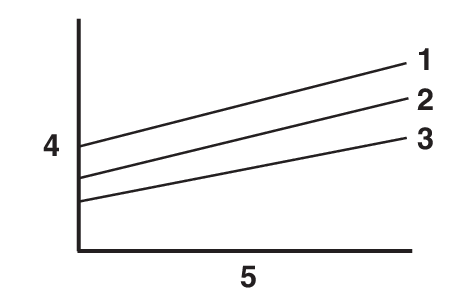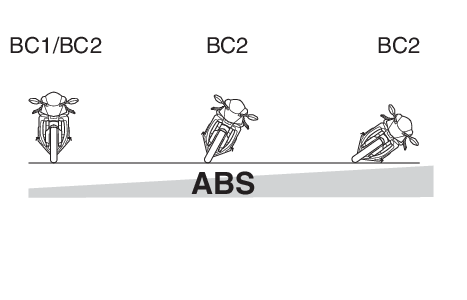Yamaha Ride Control is a system that incorporates numerous sensors and controls to support an improved riding experience. The vehicle senses and can react to forces along the longitudinal (front-to-back), lateral (left-to-right), and vertical (up-and-down) axes. Lean angle and G-force accelerations are also detected. This information is processed multiple times a second and the related physical systems are automatically adjusted as necessary. The following functions represent individual YRC items which can be turned on/off or adjusted to suit various riders and riding conditions. For setting details, see pages and .
The Yamaha Ride Control (YRC) system is not a substitute for the use of proper riding techniques or the expertise of the operator. This system cannot prevent loss of control caused by rider errors such as traveling faster than warranted by road and traffic conditions, including loss of traction due to excessive speed when entering turns, when accelerating hard at a sharp lean angle, or while braking, and it cannot prevent front wheel slip or front wheel lift. As with any motorcycle, always ride within in your limits, be aware of surrounding conditions, and ride appropriately for those conditions. Become thoroughly familiar with the way the motorcycle handles with various YRC settings before attempting more advanced maneuvers.
PWR
The power delivery mode system consists of four different control maps which regulate throttle valve opening in relation to the degree of throttle grip operation, thus providing you with a selection of modes to fit your preferences and the riding environment.

- PWR 1
- PWR 2
- PWR 3
- PWR 4
- Throttle valve opening
- Throttle grip operation
Traction control system
The traction control system helps maintain traction when accelerating. If sensors detect that the rear wheel is starting to slip (uncontrolled spinning), the traction control system assists by regulating engine power as needed until traction is restored. The traction control system indicator/warning light flashes to let the rider know that traction control has engaged.
This traction control system automatically adjusts according to the vehicle’s lean angle. To maximize acceleration, when the vehicle is upright a less amount of traction control is applied. When cornering, a greater amount of traction control is applied.

- The traction control system may engage when the vehicle travels over a bump.
- You may notice slight changes in engine and exhaust sounds when the traction control or other YRC systems engage.
- When the traction control system is turned off, SCS, LCS, and LIF are also turned off automatically.
The traction control system is not a substitute for riding appropriately for the conditions. Traction control cannot prevent loss of traction due to excessive speed when entering turns, when accelerating hard at a sharp lean angle, or while braking, and cannot prevent front wheel slipping. As with any vehicle, approach surfaces that may be slippery with caution and avoid especially slippery surfaces.
When the key is turned to “ON”, the traction control system automatically turns on. The traction control system can be turned on or off manually only when the key is in the “ON” position and the motorcycle is stopped.
Turn the traction control system off to help free the rear wheel if the motorcycle gets stuck in mud, sand, or other soft surfaces.
Use only the specified tires. (See page .) Using different sized tires will prevent the traction control system from controlling tire rotation accurately.
SCS
The slide control system regulates engine power output when a sideward slide is detected in the rear wheel. It adjusts power output based on data from the IMU. This system supports the traction control system to contribute to a smoother ride.
EBM
The engine brake management system reduces engine torque when decelerating. The fuel injection, ignition timing, and electronic throttle valve are electronically adjusted by the ECU. There are 3 settings to suit the track, riding conditions, or your personal preference.

- EBM1
- EBM2
- EBM3
- Engine brake force
- Engine r/min
Make sure the engine has sufficiently slowed before shifting to a lower gear. Engaging a lower gear when the engine speed is too high could make the rear wheel lose traction. This could cause loss of control, an accident and injury. It could also cause engine or drivetrain damage.
LCS
The launch control system helps the rider achieve smooth and swift launches from the starting grid. It keeps engine speed from rising when the throttle grip is fully turned. The LCS regulates engine power output in conjunction with the traction control system and LIF systems for optimal traction and reduced wheel lift.
Even when using LCS, the clutch lever must be released gradually to avoid clutch damage.
LCS is intended for track use only.
Quick shifter
The quick shifter allows for clutch lever-less, electronically-assisted shifting. When the sensor on the shift rod detects the appropriate motion in the shift pedal, engine power output is momentarily adjusted to allow for the gear change to occur.
The quick shifter does not operate when the clutch lever is pulled, therefore normal shifting can be done even when the quick shifter is set to on. Check the quick shifter indicator for current status and usability information.
| Quick shifter usability | Indicator | Situation |
| Upshifting OK |  |
Accelerating |
| Downshifting OK |  |
Decelerating |
| Quick shifter cannot be used |  |
Stopped |
| Quick shifter turned off |  |
Turned off |
Upshifting conditions
- Vehicle speed of at least 20 km/h (12 mi/h)
- Engine speed of at least 2200 r/min
- Accelerating (open throttle)
Downshifting conditions
- Vehicle speed of at least 20 km/h (12 mi/h)
- Engine speed of at least 2000 r/min
- Engine speed sufficiently away from red zone
- Decelerating and throttle fully-closed
- QS
 and QS
and QS  can be individually set.
can be individually set. - Shifting into or out of neutral must be done using the clutch lever.
LIF
The lift control system reduces the rate at which the front wheel will continue to rise during extreme acceleration, such as during starts or out-of-corner exits. When front-wheel lift is detected, engine power is regulated to slow front-wheel lift while still providing good acceleration.
BC
The brake control system regulates hydraulic brake pressure for the front and rear wheels when the brakes are applied and wheel lock is detected. This system has two settings.
BC1 is standard ABS, which adjusts brake pressure based on vehicle speed and wheel speed data. BC1 is designed to engage and maximize braking when the vehicle is upright.
BC2 uses additional data from the IMU to regulate applied brake power when cornering to suppress lateral wheel slip.

The brake control system is not a substitute for the use of proper riding and braking techniques. The brake control system cannot prevent all loss of traction due to over-braking from excessive speed, or lateral wheel slip when braking on slippery surfaces.
ERS (YZF-R1M)
The electronic racing suspension by ÖHLINS® features OBTi (objective-based tuning interface) for simplified, situation-focused setting changes of the automatic suspension control modes. In addition, there are manual modes which offer a finely-tuneable traditional suspension set-up. The ERS system is controlled by the SCU which can adjust the front and rear suspension’s compression stroke and rebound stroke damping forces independently. The automatic modes will adjust suspension damping forces based on running conditions.
